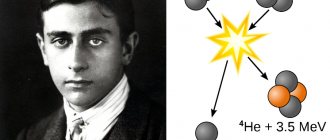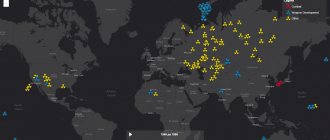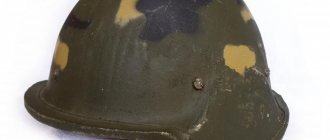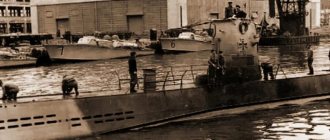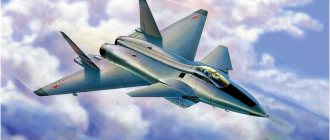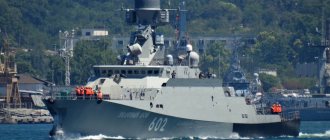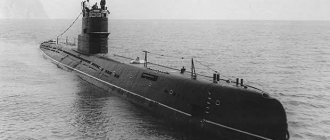The nuclear bomb is the most powerful weapon invented by mankind. The two atomic explosions that thundered over Hiroshima and Nagasaki (August 6 and 9, 1945) became a moment that changed the history of civilization, changing the worldview of people and the policies of states.
Aerial photograph taken from the B-29 "Enola Gay" bomber
The first explosion was the practical result of three years of efforts by American scientists, but theorists thought about the possibility of military use of atomic reactions much earlier.
The terrible power of the atom.
0
See all photos in the gallery
In the 1930s, as the world approached the beginning of World War II, a revolutionary process in theoretical physics, invisible to most, was taking place. Scientists from different countries advanced further and further in the study of nuclear physics. At the very end of 1938, German physicists Otto Hahn and Fritz Strassmann established that the atomic nucleus of uranium was in a state of instability. It is capable of splitting, that is, dividing into two parts, releasing a huge amount of energy. Based on the discovery of Hahn and Strassmann, physicists in a number of countries independently predicted the possibility of a self-sustaining chain reaction in a certain mass of uranium. Not only to ordinary people, but also to politicians, all this fuss of scientists seemed frivolous and incapable of influencing world processes.
0
Meanwhile, physicists started talking about the possibility of creating, based on new discoveries, weapons that humanity had not yet known. We were talking about a bomb, a single charge of which could destroy an entire city, a bomb, the possession of which would allow the country that owned it to dictate its will to the world. This discovery seriously alarmed scientists. The Nazi regime in Germany did not hide its growing appetites, and if a new super-powerful weapon fell into the hands of Hitler, then it was scary to even think about the consequences.
×
Dangers of Nuclear Weapons
According to rough estimates, by 1987 the world had accumulated up to 63,000 nuclear warheads. This number has decreased since its peak, and is now estimated at between 14,000 and 16,000 units (excluding tactical weapons). After the collapse of the USSR, Ukraine, Belarus, and Kazakhstan abandoned their nuclear status (warheads were taken to Russia in 1996). The NPT (Non-Proliferation of Nuclear Weapons) Treaty was signed by all nuclear states except Pakistan, India, and Israel (presumably possessing nuclear weapons). North Korea withdrew from the NPT on the eve of its own tests. Considering that flight time allows one to detect the launch time of missiles (ground and underwater) and launch their own in response, the theory of the first unpunished strike has become an unrealistic strategy. Any nuclear conflict could end in a full-fledged war. According to experts, the detonation of several thousand warheads will destroy humanity. The theory of “nuclear deterrence” is still working. But there have already been many crisis situations in which a nuclear war could have started by accident, even to the point of failure of radar stations. THIS IS INTERESTING. Disassembling obsolete atomic charges is no less dangerous than assembling them. Thus, in one of the workshops of Zarechny, during the dismantling of decommissioned ammunition, spontaneous combustion of uranium occurred (2003). Uranium does not explode when burned, but a large fire can set off the fuses of serviceable warheads in salvage yards. Sensible politicians, scientists, and military experts understand that missiles with nuclear warheads have lost their importance as “first strike” weapons. But statements about the possibility of using nuclear weapons continue to be heard from the leaders of authoritarian states such as the DPRK. The danger of “nuclear winter” continues to threaten the world.
Einstein writes to the President.
0
The scientific potential of Germany was significantly weakened by the expulsion from the country of physicists of “non-Aryan origin,” including the most famous scientist in the world, Albert Einstein. Nevertheless, many venerable scientists continued to work for the Fuhrer, including Hahn and Strassmann, whose research so excited the scientific world. Among the majority of physicists in the world, anti-fascist sentiments prevailed. In the summer of 1939, Leo Szilard and Eugene Wigner asked Albert Einstein to write a letter to US President Franklin Roosevelt, in which he would familiarize the politician with the new danger.
0
Einstein agreed, and on August 2, a letter in which the physicist introduced the American leader to the dangerous research being carried out in Nazi Germany was sent. The appeal to Einstein was due to the fact that only he at that time had sufficient authority to force the powers that be to listen. With great difficulty, only in October 1939 did the initiators of the letter manage to transfer it to Roosevelt. Despite Einstein's authorship, the president was skeptical, but then, after consulting with advisers, he established a "Uranium Committee" tasked with studying the problem more carefully.
Delivery means
Atomic warheads can be delivered to targets by almost modern missiles that allow ammunition to be placed inside.
There is a division of delivery vehicles into the following groups:
- tactical (weapons for destroying air, sea and space targets), designed to destroy enemy military equipment and human resources on the front line and in the immediate rear;
- strategic - defeating strategic targets (in particular, administrative units and industrial enterprises located behind enemy lines);
- operational-tactical destruction of targets that are within the operational depth range.
Game ahead.
0
In November 1939, the Uranium Committee reported to Roosevelt: the use of uranium would make it possible to create weapons with destructive power significantly superior to anything known. From that moment on, the United States began work on creating its own atomic bomb. Leading American physicists, as well as scientists from other countries who emigrated to the United States, were involved in the implementation of the project. Work on “atomic projects” was carried out in a number of countries, but during the war, only the United States had sufficient funds to confidently move forward.
0
The implementation of the project required the creation of several new military factories, around which cities with increased secrecy were formed. At the same time, American intelligence efforts were aimed at obtaining information about how the German atomic project was progressing. German research stalled without the necessary state support - Hitler needed weapons that could be used immediately, and not after a few years. In July 1942, the American program to create an atomic bomb received additional support - Roosevelt obtained consent from British Prime Minister Winston Churchill for the main participants in the British Tube Alloys atomic project to move to the United States.
Technical task
When in 1945 the issue of creating a Soviet nuclear bomb became almost a priority, one of the project leaders, Yu. Khariton, drew up a plan for the development of two versions of the projectile. On June 1, 1946, the plan was signed by senior management.
According to the assignment, the designers needed to build an RDS (special jet engine) of two models:
- RDS-1. A bomb with a plutonium charge that is detonated by spherical compression. The device was borrowed from the Americans.
- RDS-2. A cannon bomb with two uranium charges converging in the gun barrel before reaching a critical mass.
In the history of the notorious RDS, the most common, albeit humorous, formulation was the phrase “Russia does it itself.” It was invented by Yu. Khariton’s deputy, K. Shchelkin. This phrase very accurately conveys the essence of the work, at least for RDS-2.
When America learned that the Soviet Union possessed the secrets of creating nuclear weapons, it began to desire a rapid escalation of preventive war. In the summer of 1949, the “Troyan” plan appeared, according to which on January 1, 1950 it was planned to begin military operations against the USSR. Then the date of the attack was moved to the beginning of 1957, but with the condition that all NATO countries join it.
Commonwealth of physicists and generals.
0
The preparatory work has been completed. On August 13, 1942, the White House decided to begin work on the direct creation of an atomic bomb. The project was codenamed "Manhattan". General Leslie Groves and physicist Robert Oppenheimer were appointed project leaders. The entire scientific part was entrusted to Oppenheimer, and Groves had to deal with administrative issues and control over scientists who were not accustomed to strict secrecy and military discipline.
0
The budget for the Manhattan Project was an astronomical sum of two billion dollars. But such expenses made it possible to move in several ways at once. Thus, the dispute about which bomb to create—uranium or plutonium—was resolved by an order to create both.
0
To accumulate reserves of weapons-grade plutonium, the city of Hanford was created, in which three special nuclear reactors were built. Another city built from scratch, Oak Ridge, arose thanks to the uranium enrichment facility built there. In November 1942, construction began on the secret city of Los Alamos in New Mexico. It was in this city that it was planned to build the world's first atomic bombs.
"He is a genius. A real genius"
The next task posed by Groves was to organize a separate laboratory in which all the scientists and engineers working on the bomb could be gathered. Until now, they had been dispersed in university laboratories across the country, from New York to California, and Army commanders were terribly worried that this would make it extremely difficult to control leaks of classified information. General Groves decided to appoint Robert Oppenheimer as director of the new top-secret laboratory.
Robert Oppenheimer was born on April 22, 1904 into a family of non-religious Jews. At school he was interested in many things - from literature and Greek to chemistry and mineralogy. At Harvard, his main specialization was chemistry, but his range of interests was much wider. In a letter to a friend, somewhat pompously, he talked about his studies at the university:
I write countless essays, notes, poems, stories and all sorts of rubbish; I go to the mathematics library, and also to the philosophy library, where I spend time reading Bertrand Russell's Meinherr and contemplating the most beautiful girl writing a dissertation on Spinoza - delightfully ironic, isn't it? I stink up three different laboratories, listen to gossip about Racine, treat myself to tea and chat (knowingly) with a few lost souls, go away for the weekend to channel my energy into laughter and exhaustion, read Greek, make faux pas, look for letters to table and I want to die. Voila.
Leslie Groves and Robert Oppenheimer
United States Army
Share
At some point, Oppenheimer realized that the most interesting areas of chemistry for him were at the interface with physics, and after graduating from university in 1924, he decided to go to the very heart of modern experimental physics - the Cavendish Laboratory at the University of Cambridge (about the discoveries made in Cavendish, We talked about it in the material “Quantum Revolution and Mustard Gas”).
Oppenheimer's abilities as an experimentalist did not impress Ernest Rutherford, who was the director of the laboratory at the time. The discoverer of the electron, J. J. Thomson, agreed to take Oppenheimer under his wing, but the work assigned to him was not going well for Oppenheimer, and this drove the American into severe depression - he even had to seek help from a psychiatrist. Salvation, however, came in the person of Niels Bohr, who visited Cambridge that same year - Oppenheimer decided to become a theoretical physicist. It is interesting that a little more than 10 years ago Bohr himself, suffering from unproductive work with Thomson, found a “second wind” after meeting Rutherford.
For mastering the profession of a theorist, the German city of Göttingen, where Max Born and Werner Heisenberg worked on the foundations of quantum mechanics (more about this in the material “Germany, of course, Uber Alles”), was better suited than Cambridge. Oppenheimer moved there in the fall of 1926 and the following year he defended his Ph.D. thesis with honors. The work at Göttingen did make a significant contribution to quantum mechanics: in particular, Oppenheimer, together with Born, succeeded in constructing a quantum mechanical description of molecules. Success gave 23-year-old Oppenheimer self-confidence. James Frank, a Nobel laureate who took the 23-year-old American's candidate exam, reportedly exclaimed after finishing: “What a relief! A little more and he would have started examining me.”
After returning to the United States, 25-year-old Robert Oppenheimer received positions at two California universities, Berkeley and Caltech. There, a circle of students quickly formed around him, which eventually, in the words of Oppenheimer himself, became “the largest school of theoretical physics in the country.” The young teacher was attracted by his willingness to immerse himself deeply in joint work, his taste for modern physics - that is, his understanding of which problems are the most interesting and relevant - and, last but not least, his extraordinary personality. On campus, everyone talked about how he learned Sanskrit to read the original Bhagavad Gita, his passion for piping hot food and the ease with which he made his colleagues feel like idiots. Students adopted his arrogant style. Fermi, in a letter to Segre, jokingly described one of the seminars: “Emilio, I am getting old and rusty. I can’t understand the highbrow theories that Oppenheimer’s students are developing. I went to a seminar and became depressed because I didn’t understand anything. Fortunately, the last phrase of the speaker cheered me up a little: “And this is Fermi’s theory of beta decay” (we talked about Fermi’s discoveries in the material “But a cruel time is coming to us”).
Oppenheimer was not the most obvious candidate for the post of director of a top-secret laboratory for creating superweapons. He was a theorist, he didn't have a Nobel Prize. And most importantly, General Groves had every reason to doubt his political reliability.
Like many intellectuals, Oppenheimer sympathized with left-wing ideas. In 1936, a civil war broke out in Spain, in which right-wing rebels led by General Francisco Franco and supported by Hitler and Mussolini fought against the left-wing republican government, which was helped by the USSR. At a fundraiser for Spanish Republicans, Oppenheimer met Jean Tatlock, an activist with the Communist Party of the USA. They began dating, and Jean introduced him to the circle of leftist activists. Relations with Tatlock were turbulent, the couple came together and diverged several times, and in 1940 Oppenheimer married another communist, Catherine Puening. In addition, Robert's younger brother Frank was a communist.
Catherine Puening (left) and Jean Tatlock (right)
Share
And yet, Groves still believed that Oppenheimer should lead the atomic project. "He is a genius. A true genius. <…> He knows everything about everything, he can delve into any proposal. Not really, of course. There is something he has no idea about. He doesn’t know anything about sports,” Groves said in a post-war interview.
Special purpose regiment.
0
Even before the first atomic bombs were built, in the summer of 1944, a special 509th air regiment was created. Its pilots flew specially designed B-29 bombers with extended bomb bays. Unlike their colleagues, the pilots of the 509th Aviation Regiment practiced the same technique: approaching the target in normal weather, dropping, and then quickly turning around and moving to a safe distance so that the carrier would not be destroyed by powerful air currents. The command believed that by the time the 509th Air Regiment received a combat order, resistance from enemy air defenses and fighters would be reduced to a minimum.
0
By June 1944, the Manhattan Project employed approximately 129,000 employees, of whom 84,500 were construction workers, 40,500 were operators, and 1,800 were military personnel. Then the number of military personnel increased to 5,600.
The most powerful bomb in the world
The most powerful bomb in the history of mankind belongs to the USSR. It was so devastating that it was included in the Guinness Book of Records.
We are talking about the Tsar Bomba, which was dropped from a bomber onto the Novaya Zemlya archipelago in 1961. The bomb was so bulky that it did not fit into the Tu-95, it stuck out from the plane, and special fastenings had to be installed.
The bombers could have been injured, and therefore a huge parachute was built in advance for the Tsar Bomba, which would have somewhat slowed down its fall. So much so that the pilots do not receive harm, but are able to fly to a safe distance. As a result, the bomber was even thrown a thousand meters, but control over it was restored in time.
It is not difficult to guess that the consequences were terrifying. The explosion was so powerful that buildings that were 55 kilometers from the place where the Tsar Bomba was dropped were damaged. And hundreds of kilometers from the epicenter, damage was also noticeable. After the explosion, radio communications stopped working for about an hour.
The only thing that can be said is that the fireball did not reach the ground, exploding while still in the air. That is why these lands did not receive a large share of radiation exposure.
Initially, this bomb was intended to be much more powerful. But testing it was considered too risky. It's scary to imagine what the outcome would have been.
Treaty of countries
Negotiations were held for a long time, which ended in 1963. Their result was the Treaty Banning Tests of Nuclear Weapons in Three Environments. Yes, yes, not in countries, but in environments. Under this treaty, it was prohibited to test bombs on the surface of the earth, as well as under water and in space.
Surprisingly, Sakharov, the direct creator of weapons of mass destruction, became one of the most ardent opponents of the proliferation of nuclear weapons. He would later receive the Nobel Prize, as well as some nickname: “The Conscience of Humanity.”
At the moment, the following countries have nuclear weapons: USA, Russia, Great Britain, China, India, France, Pakistan, North Korea. Supposedly available in Pakistan. But only five of them agreed to sign the Treaty on the Non-Proliferation of Such Weapons. We are talking about the USA, Russia, China, Great Britain and France.
"Dubina" against Stalin.
0
By the spring of 1945, three atomic charges had been created: a shell-free plutonium device called the “Thing,” as well as two bombs—the uranium “Baby” and the plutonium “Fat Man.” After the death of President Franklin Roosevelt on April 12, 1945, Harry Truman became the country's leader. The new president was a hardliner in relations with the Soviet Union and viewed the new weapon as “a cudgel against Stalin.”
0
Since the war in Europe was practically over, it was planned to test atomic bombs on Japanese territory. However, this had to be preceded by testing at the test site. Truman hurried the scientists - he wanted to have a new weapon by the beginning of the Potsdam Conference of the victorious countries in order to gain a powerful argument in the diplomatic struggle.
Semipalatinsk test site
The atomic bomb in the USSR was first tested at the test site in Semipalatinsk (Kazakhstan). On August 29, 1949, a nuclear device with a yield of 22 kilotons shook the Kazakh soil. Nobel laureate physicist Otto Hanz said: “This is good news. If Russia has atomic weapons, then there will be no war.” It was this atomic bomb in the USSR, encrypted as product No. 501, or RDS-1, that eliminated the US monopoly on nuclear weapons.
Operation Trinity.
0
The “Thing” was chosen for the first atomic test in history. The explosion was scheduled for July 16, 1945 at the Alamogordo test site. The charge was installed on a thirty-meter steel tower surrounded by measuring equipment. Three observation posts were set up within a radius of ten kilometers, and a dugout for a command post was set up at a distance of 16 kilometers. The first atomic test was codenamed Trinity. There were a lot of forecasts regarding its results - from complete failure to a global catastrophe that would destroy the planet. But Oppenheimer hoped that the bomb would correspond to the planned power.
0
The testing was in jeopardy due to disgusting weather in the area of the test site. Oppenheimer almost quarreled with Groves. The military leader insisted on testing in any case, and the scientific one pointed out that with strong winds, a radioactive cloud could cover nearby American cities. But by 5:30 am the weather had normalized, and the explosion was carried out at the estimated time.
0
The effect exceeded expectations. The power of the explosion was about 18 kilotons of TNT. The crater after the explosion was about 76 meters in diameter. The shock wave spread over 160 kilometers, and the mushroom cloud rose to a height of 12 kilometers. When the cloud cleared, scientists and military personnel went to the epicenter in tanks lined with lead plates on the inside. What they saw made a different impression on them. The military rejoiced, and the physicists were depressed, realizing what kind of genie had just been released from the bottle.
Thermobaric death
On February 1, 2000, immediately after the next test of a thermobaric bomb, Human Rights Watch, a CIA expert, described its effect as follows: “The direction of the volumetric explosion is unique and extremely life-threatening. First, people in the affected area are affected by high pressure of the burning mixture, and then by a vacuum, actually a vacuum, tearing the lungs. All this is accompanied by severe burns, including internal ones, since many manage to inhale the fuel-oxidative premix.”
However, with the light hand of journalists, this weapon was called a vacuum bomb. Interestingly, in the 90s of the last century, some experts believed that people who died from a “vacuum bomb” seemed to be in space. They say that as a result of the explosion, oxygen instantly burned out, and for some time an absolute vacuum was formed. Thus, military expert Terry Garder from Jane magazine reported on the use of a “vacuum bomb” by Russian troops against Chechen militants in the area of the village of Semashko. His report said that those killed had no external injuries and died from ruptured lungs.
"Doctor Groves is pleased"
0
In order to maintain secrecy and not cause panic among the local population, the version invented by General Groves was transmitted to the press. The Associated Press reported: “At dawn on July 16, an ammunition depot exploded in the desert near Alamogordo Air Force Base, New Mexico. The explosion was so strong that it attracted attention in Gallup, 376 kilometers away.” On the evening of July 16, 1945, Harry Truman, who was in Potsdam, received a coded message: “The operation was performed this morning. The diagnosis is not yet complete, but the results seem satisfactory and already exceed expectations. Dr. Groves is pleased." This meant that the atomic bomb tests were successful. The US President was jubilant - he had received a powerful argument to influence the Russians. At the very first meetings of the Potsdam Conference, he began to conduct the discussion decisively, being confident in the strength of his positions.
Detonation options
Detonation can be achieved by connecting two main circuits or a combination of them.
Ballistic or gun design
Its use is only possible in charges containing uranium. To carry out an explosion, one block containing a fissile substance having a subcritical mass is fired into another block, which is stationary.
Implosive circuit
An inward-directed explosion is produced by compressing the fuel, during which the subcritical mass of the fissile substance becomes supercritical.
